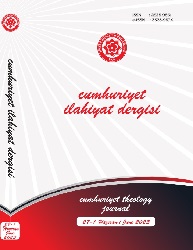Abdullah Bosnevî’nin Zülkarneyn’in Batı Seferine Dair İşârî Tefsir Risalesi
‘Abdallāh Bosnawī’s Isharī Tafsir Treatise on Dhu’l-Qarnayn’s Western Expedition
Author(s): Bünyamin AçıkalınSubject(s): Hermeneutics, Qur’anic studies
Published by: Cumhuriyet Üniversitesi İlahyat Fakültesi
Keywords: Ṭafsīr; Isharī Ṭafsīr; Abdallāh Bosnawī; Kitābu mashriq al-rūḥānī; Dhu’l-Qarnayn; Waḥdat al-wujūd;
Summary/Abstract: From the moment it graced the earth with the light of guidance, the Qur’ān has been the centre of attention for Muslims. Its rich dimensions of meaning have attracted the attention of scholars in basic Islamic sciences as well as Sufis. Some of these Sufis left behind valuable works by feeding from the table of science, civilization and wisdom in Anatolian lands. One of them, ‘Abdallāh Boṣnawī, is one of the representatives of Ibn al-’Arabī’s school, which has an important place in the tradition of Islamic thought as well as in the field of Sufism. He was also an Ottoman intellectual who successfully annotated Ibn al-ʿArabī’s work named Fuṣūṣ al-Ḥikam for the first time in Turkish and Arabic. In his works, in addition to introducing Ibn al-’Arabī’s thought, he provided original explanations of the difficult aspects of this tradition. Recognizing these characteristics of Boṣnawī, many contemporary researchers have written articles, theses and papers on his works. Despite this, most of Boṣnawī’s treatises on tafsīr and Sufism are still in manuscript form and waiting to be introduced to the academic world. Boṣnawī’s “author’s calligraphy” treatises are exegesis of twenty-five verses and two sūrahs. As far as we can find, only one treatise on the exegesis of a verse and a sūrah has been introduced so far. His treatise, which is the subject of this study, in which he interpreted by isharī method the story of Dhu’l-Qarnayn, which is described mysteriously and symbolically in the Qur’ān, in the context of the 86th verse of Ṣurat al-Kahf, is one of these verse exegesis. The treatise, in which the verse is interpreted according to the theory of Waḥdat al-wujūd, which is influential in Islamic thought, contains original interpretations. In our study, we have applied the methods of analyzing the content of this manuscript, examining and evaluating the tafsir and Sufi literature to the extent of its relevance to the subject, and comparing it with the manuscript. Born in Bosnia, Bosnawî travelled to the major centres of Islamic civilization such as Istanbul, Bursa, Egypt and Damascus in search of knowledge and wisdom, and died in Konya. Boṣnawī, who seems to have had a strong knowledge of basic Islamic sciences, studied Sufism theoretically at the same time he practised it by becoming a Melāmī. The zāhirī exegesis of the verses that are the subject of the treatise by other commentators emphasizes the differences in the Qiraat, who Dhu’l-Qarnayn is, where the sun sets, and how this setting takes place. The author, who is observed to use exegetical methods such as explaining the verse with the verse, observing the relationship between siyāq-sibāq, and giving examples of how a word is used by the Arabs, has been observed to benefit from classical exegesis in his literal interpretations, but he does not go into too much detail. In the isharī exegeses of the exegetes other than Boṣnawī, Sufi explanations were made about the people, places and objects in the parable. While explaining the aforementioned elements, the exegetes also encouraged people to worship, to do good deeds, to discipline their nafs, to improve their morals, and to advance in the stages of the sulūk. The author also showed this sensitivity and pointed out similar issues in his isharī tafsirs. However, unlike other exegetes, Boṣnawī, in line with the historical stages of Sufism, adhered to the tradition of theoretical-Sufi interpretation and gave ontological explanations about the creation of man by God Almighty. The content of the treatise is introduced under headings appropriate to the subject matter. After the ḥamdala and ṣalwala, which summarize his thoughts on Dhu’l-Qarnayn, the author introduces the stages of physical, spiritual and cardiac formation. He explained that by Dhu’l-Qarnayn it is possible to mean the al-laṭīfaṭu’l-insāniyya and the al-insānu’l-kāmil. Boṣnawī frequently used the terms of waḥdat al-wujūd in his explanations, such as “marātib al-kawniyya, tajalliyyāt al-Rabbāniyya, jilā-istijlā, unṣuriyyāt, Raḥmānī amāī breath, shatr al-imkān, shatr al-wujūd, ifāḍa-istifāḍa, qaws al-wujūb wa’limkān”. On the other hand, the author exegeted the elements in the parable such as “Dhu’l-Qarnayn, the eye, the sun, the east, the west, the sea, the two sets” in different ways according to the degrees reached by the ascetic. Boṣnawī tried to explain throughout his treatise that the veils of the subtleties in creation will be opened according to the levels of sulūk. In these respects, the inclusion of this work in the literature is important in terms of introducing the isharī interpretations made by a competent scholar and Sufi in a manuscript about the places, persons and objects in the verses related to the parable of Dhu’l-Qarnayn.
Journal: Cumhuriyet İlahiyat Dergisi
- Issue Year: 27/2023
- Issue No: 1
- Page Range: 249-266
- Page Count: 18
- Language: Turkish

